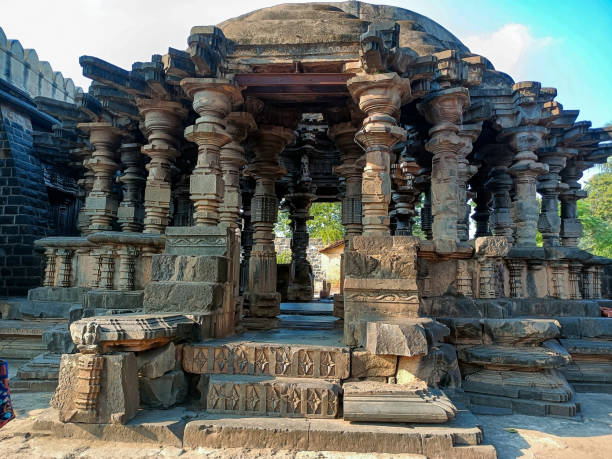
The Kopeshwar Tample
Kopeshwar Temple, located in the town of Khidrapur near Kolhapur in Maharashtra, is a notable historical and architectural landmark. Here’s a comprehensive overview of the temple:
Location: The Kopeshwar Temple is situated in the village of Khidrapur, approximately 50 kilometers southeast of Kolhapur. The temple is nestled in a scenic area surrounded by lush landscapes.
Kopeshwar Temple is not just a religious site but also a cultural and architectural gem, reflecting the rich heritage of the Chalukyan dynasty and offering a glimpse into India’s historical and spiritual past.
Kopeshwar Temple is a notable historical and architectural site located in the village of Khidrapur in the Kolhapur district of Maharashtra, India. It is renowned for its intricate carvings and historical significance. Here's a comprehensive overview of the temple:
Historical Significance:
Chalukyan Dynasty and Historical Context:
1. Chalukyas of Badami:Origins: The Chalukyas were a prominent dynasty that ruled parts of southern and central India. The Chalukyas of Badami (or Early Chalukyas) were the earliest among the Chalukyan dynasties and established their rule in the 6th century CE.
Rulers: They are known for their contributions to art, architecture, and culture. Notable rulers include Pulakeshin I, Pulakeshin II, and Vikramaditya II.
2. Chalukyas of Kalyani (Western Chalukyas):
Rise: The Western Chalukyas, also known as the Chalukyas of Kalyani, emerged in the 10th century CE. They ruled from their capital, Kalyani (modern-day Basavakalyan in Karnataka).
Prominent Ruler: Somesvara III, the king during whose reign the Kopeshwar Temple was constructed, was a significant ruler of this dynasty. His reign (r. 1127–1138 CE) is noted for its achievements in architecture and patronage of arts.
Construction of the Kopeshwar Temple:
1. Foundation:
Date: The temple was built in the early 12th century CE, specifically around 1050–1150 CE, during the reign of Somesvara III. This period was marked by extensive temple construction and patronage of the arts.
2. Architectural Style:
Hemadpanthi Style: The Kopeshwar Temple is a prime example of the Hemadpanthi architectural style, named after Hemadri Pandit, a minister and architect who was influential in this style. This style is characterized by the use of local stone and detailed carvings.
Design: The temple features a square plan with a central sanctum (garbhagriha) and an adjoining hall (mandapa) supported by intricately carved pillars.
Cultural and Religious Significance
1. Hindu Religion:
Deity: The temple is dedicated to Lord Shiva, a major deity in Hinduism known for his role as the destroyer and regenerator of the universe. The central lingam is the focal point of worship.
Rituals and Festivals: The temple plays a significant role in regional Hindu worship practices and festivals, particularly Maha Shivaratri, which attracts numerous devotees.
2. Patronage and Influence:
Chalukyan Contributions: The Chalukyas were known for their patronage of Hindu temples and the arts. The Kopeshwar Temple reflects their devotion and the high level of craftsmanship achieved during their reign.
Influence: The architectural and artistic innovations seen in the Kopeshwar Temple influenced subsequent temple designs and construction techniques in the region.
Historical Developments and Preservation:
1. Post-Chalukyan Period:
Decline: Following the decline of the Chalukyan dynasty, the temple came under the influence of various regional powers. Despite this, it continued to be an important religious and cultural site.
Medieval Period: Over the centuries, the temple faced various challenges, including invasions and natural wear. However, it retained its significance among local devotees.
2. Modern Era:
Preservation Efforts: In recent decades, the temple has been subject to preservation and restoration efforts to maintain its historical and architectural integrity. These efforts are aimed at protecting the intricate carvings and ensuring that the temple remains a vibrant place of worship and cultural heritage.
The Kopeshwar Temple stands as a significant monument from the Chalukyan era, reflecting the architectural prowess and religious devotion of its time. Its history offers insights into the cultural and artistic achievements of the Chalukyan dynasty and the enduring legacy of their contributions to Indian heritage.